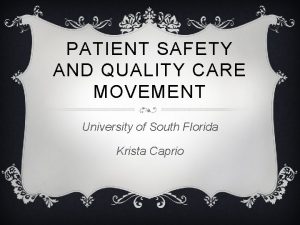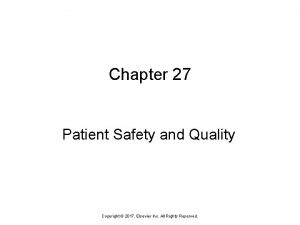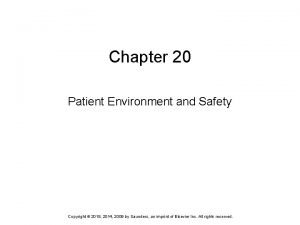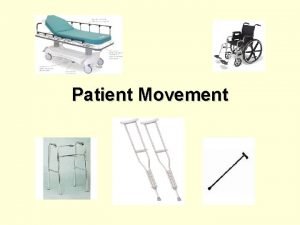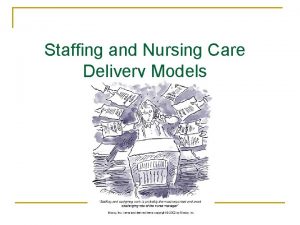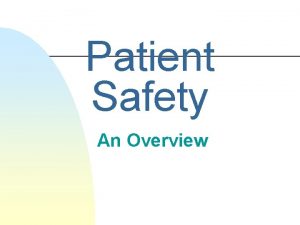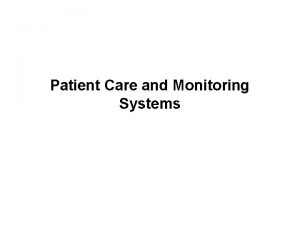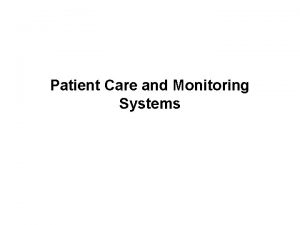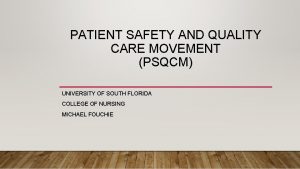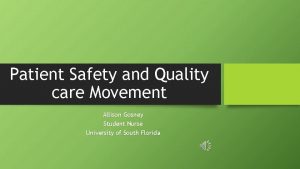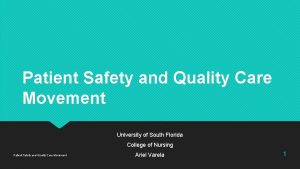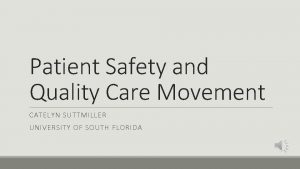Patient Safety and Quality Care Movement UNIVERSI TY










- Slides: 10

Patient Safety and Quality Care Movement UNIVERSI TY OF SOUTH FLORIDA COLLEGE O F NURSING BRITT A NY B OLIN

Introduction • According to the IOM (2010), medical errors result in as many as 98, 000 deaths per year 1 • According to the CDC, medical errors are the 3 rd leading cause of death in the United States 2 • Medical errors can lead to adverse events, and even sentinel events Purpose • Preventing, Recognizing, Mitigating • The movement started when a study by the IOM was published in 1999 called, To Err is Human 3 • Root Cause Analysis

What is PSQCM? Patient Safety 4 Quality Care 4 • “Indistinguishable from the delivery • 5 Ds of quality health care” • “The prevention of harm to patients” - safe - effective - patient centered - timely - efficient - equitable

Types of Safety Errors • Latent 4 • Active 4 • Organizational 4 • Technical 4

Institute of Medicine (IOM) Concepts Four-Part Plan 4 1. National Center for Patient Safety 2. Mandatory and Voluntary Reporting System 3. Role of Consumers, Professionals, and Accreditation Groups 4. Building a Culture of Safety (safe, patient-centered, effective, timely, efficient, equitable)

Significance of PSQCM to Nursing? Communication 5 Integrate Coordinate Education Staffing 6

Significance of PSQCM to Student? Quality and Safety Education for Nurses (QSEN)7

Conclusion • Identify errors in patient safety using Root Cause Analysis • Initiate solutions • Prevent these medical errors from happening again • Improved patient safety

References 1. Kohn LT, Corrigan JM, Donaldson MS, editors. To err is human: building a safer health system. Washington, DC: National Academy Press, Institute of Medicine; 1999. 2. National Center for Health Statistics. (2017, March 17). Retrieved February 09, 2018, from https: //www. cdc. gov/nchs/fastats/leading-causes-of-death. htm# 3. Donaldson MS. An Overview of To Err is Human: Re-emphasizing the Message of Patient Safety. In: Hughes RG, editor. Patient Safety and Quality: An Evidence. Based Handbook for Nurses. Rockville (MD): Agency for Healthcare Research and Quality (US); 2008 Apr. Chapter 3. Available from: https: //www. ncbi. nlm. nih. gov/books/NBK 2673/ 4. Mitchell, P. H. (2008). Patient safety and quality: An evidence-based handbook for nurses, MD: Agency for Healthcare Research and Quality. 5. Hughes RG (ed. ). Patient safety and quality: An evidence-based handbook for nurses. (Prepared with support from the Robert Wood Johnson Foundation). AHRQ Publication No. 08 -0043. Rockville, MD: Agency for Healthcare Research and Quality; March 2008.

References cont. 6. Nursing and Patient Safety. (2017). Retrieved from https: //psnet. ahrq. gov/primers/primer/22/nursing-and-patient-safety 7. Dolansky, M. A. , Moore, S. M. , (September 30, 2013) "Quality and Safety Education for Nurses (QSEN): The Key is Systems Thinking" OJIN: The Online Journal of Issues in Nursing Vol. 18, No. 3, Manuscript 1.
 Patient safety and quality care movement
Patient safety and quality care movement A nurse floats to a busy surgical unit
A nurse floats to a busy surgical unit Safety care behavioral safety training
Safety care behavioral safety training Primary secondary tertiary care
Primary secondary tertiary care Patient 2 patient
Patient 2 patient Chapter 20 patient environment and safety
Chapter 20 patient environment and safety Movement and non movement area
Movement and non movement area Patient movement
Patient movement Functional nursing
Functional nursing Quality control and quality assurance
Quality control and quality assurance Quality assurance concepts
Quality assurance concepts
